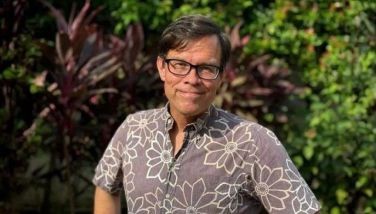Stanley Jordan plays and talks incredible music

MANILA, Philippines - One good thing about being a father of a jazz guitarist is that we can ask him to explain the brilliance of one Stanley Jordan, who treated us to something splendid over a week ago.
Aya M. Yuson is a rather reputable guitar player himself, but he came away blown away, maybe much more so than us. He also had the privilege of speaking with the divinity.
I give up my space today to Aya’s account of it all. I repeat: what appears below was written by Aya M. Yuson. I just took the pictures.
* * *
I first heard Stanley Jordan when I had just begun to play the guitar, some 20 odd years ago. I recall being amazed at the sheer mechanics involved in playing the guitar as some sort of weird hybrid keyboard-like instrument, tapping notes out with the fingertips of both the left and right hand, rather than fretting with one hand and picking or plucking with the other. It was like hearing the virtuoso Frankenstein of Joe Pass (the solo jazz guitar part) fused with Eddie Van Halen (the tapping part).
Fast forward 20 years and the amazement is trebled when witnessing firsthand just how he does it.
Thanks to the PI Jazz Festival Foundation of Sandra Lim-Viray, Jun Viray, Zenaida Celdran and Egay Avenir, scores of Stanley Jordan fans were treated to a thrilling close-up view of just how it’s done, via a workshop and a concert at Ayala Museum in Makati last Friday, the First of October.
Speaking as a guitarist, I must say that what Stanley Jordan does is so far removed from what guitarists do, that watching him do what he does is more like watching a pianist. While the notes he plays are the same as the notes other guitarists play, the technique involved in playing those notes is so alien to standard guitar technique as to be virtually incomprehensible.
What Stanley Jordan does is far beyond what most guitarists can imagine doing with or on the instrument.
 Fretboard odyssey: Stanley Jordan at the Ayala Museum
Fretboard odyssey: Stanley Jordan at the Ayala MuseumBefore the concert proper, Stanley indulged musicians and non-musicians alike in a freewheeling workshop that waxed philosophical more than it involved the nitty-gritty details of making music. Those in attendance came away heads abuzz with Zen & the Art of Touch Technique.
One valuable point made at the workshop: Practicing an instrument is in itself a way of making music. Stanley Jordan opined that even when practicing, one should avoid mere mechanical practice. Even technical practice should have at its heart something musical. It makes complete sense, of course. To practice something that is not music is to get good at something that is not music. Practice and Performance are one.
An hour and a half after the workshop came the concert proper. Stanley ascended the stage and blew us all away with a set of varied material. His set ran the gamut — from abstract Real Book-style jazz (Benny Golson’s Along Came Betty) to pretty Mozart (the andante section of Piano Concerto No. 21) to Led Zeppelin (Stairway To Heaven).
Truly special was his take on the jazz standard, My One and Only Love. His rendition was a beautiful pianistic study in byzantine bebop harmony and lush lyrical melody. Heartachingly beautiful.
At one point, Stanley sat in front of a grand piano and proceeded to play the piano and the guitar simultaneously. If anyone in the audience remained unconvinced that Mr. Jordan is an extraterrestrial in possession of at least two brains, all remaining doubt was dispelled by the act of simultaneously playing guitar and piano on a tune as tough as Along Came Betty.
Many a jaw dropped when Jordan essayed a couple of classical piano pieces on guitar: an unnamed Beethoven tune that sounded a lot like the Lovingly Yours, Helen theme song and that andante movement of Mozart’s that’s popularly known as the Theme from Elvira Madigan. To successfully execute pinnacles of piano polyphony such as Beethoven and Mozart on guitar is a feat beyond mere mortal guitarist ken.
Audience ears perked up considerably with the ostensible set-closer Eleanor Rigby. Long-time listeners no doubt recognized the tune from Jordan’s Blue Note debut “Magic Touch.” As played in concert, the tune blew everyone’s mind. Furiously tapped pentatonic cascades careened into and out of the timeless Beatles melody, and the floor was littered with fallen jaws. Awesome performance!
The audience kept Jordan onstage with an insistent standing ovation. He obliged us with a beautiful rendition of O, Holy Night, a tune on which he proved his musicianship to be beyond mere breathtaking prestidigitation. His groundbreaking touch technique went beyond digital wizardry as his magic touch cleaved to the heart of the song.
Still the audience begged for more. Jordan gave in with one last tune, Led Zeppelin’s Stairway To Heaven. Incredible tour de force! Virtually all of the tune’s original recorded parts were present and accounted for: Jimmy Page’s scrappy guitar lines, John Paul Jones’ authoritative bass thumps, Robert Plant’s keening wail, nuances and all. Virtually the only thing missing was John Bonham’s woozy swingin’ percussive bombast. Fantastic!
Thanks must go to the PI JazzFest Foundation for adhering to its vision of bringing top-flight musicians to the Philippines and bringing top-flight Pinoys to the world.
Thanks must also be extended to Sandra Lim-Viray and Zenaida Celdran for arranging an interview with Mr. Jordan last Thursday, Sept. 30, a day before his performance. The interview was between Mr. Jordan and a group of different writers, and soon spun into a freewheeling discussion about music, musicianship and music therapy. The following are some of the pithier excerpts:
PHILIPPINE STAR: Quick guitar player question about your technique: Having never seen videos of you performing, I’m guessing that your right hand plays the melody lines and your left hand plays the chords. Is this accurate?
Stanley Jordan: Yes, that’s right. Of course it really all depends on what exactly I’m going for. There are times when the left hand and the right hand trade roles. But for the most part, yes, the left hand plays accompaniment and the right hand plays the melody.
Follow-up question, again for the guitar players: Is your touch technique also applicable on acoustic guitars and/or jazz box archtops strung with thick strings or does it work only on solid-body guitars set up with low action and thin strings?
I find that the touch technique works best on certain set-ups. For me, what works best is an electric guitar with low action and thin strings. But yeah, the touch technique can also work on acoustic and with thicker strings. Take (guitarist) Michael Hedges, for example. He uses tapping on acoustic.
Yes, but when Michael Hedges does tapping on acoustic, it’s usually a lot simpler than what you do…
I don’t know… I think that by any measure, Michael Hedges is an incredible guitarist.
What exactly inspired you to revolutionize guitar technique and invent the touch technique? What gave you the idea to use both hands on the fretboard?
I started out on piano. And I loved it. I loved playing piano. In fact, to this day, I still play piano. But then my family ran into certain financial problems and we had to sell the piano. Then I tried playing the guitar. And I soon found that I enjoyed playing the guitar as well.
It’s not like I set out to innovate or revolutionize anything. I just worked out a way to play on the guitar what it was that I was hearing and imagining. And it has really taken an enormous amount of effort to work out whatever it is I do. I’ve spent a lot of time and effort working things out, in terms of the mechanics involved of which hand goes where. There’s an enormous amount of musical problem-solving involved in playing the way I do.
Aside from your revolutionary technique, one other thing that sets you apart from other jazz musicians is that you’ve also covered iconic rock tunes and pop songs and played them as one would a jazz standard…
Yeah, one thing (Blue Note head honcho) Bruce Lundvall once told me, “You know what makes you different, Stanley? You play stuff like Eleanor Rigby or Simon & Garfunkel tunes with just as much respect as you would a jazz standard like, say, (John Coltrane’s) Impressions.” I just try to play music that resonates with me on a personal level, you know? Tunes that I relate to.
Like, recently, I had a concert in the States, and at the sound check, the sound guys were playing some popular song on the PA (public address) system. And I started playing along, doing my thing, playing the melody, paraphrasing the melody, doing variations, re-harmonizing it, improvising and what have you. And the kids who were there at the sound check started going wild! They were digging it.
Perhaps it’s your openness to contemporary pop culture that makes your music resonate with so many people, jazz aficionado and average joe alike.
(At this point, Stanley Jordan beamed. He nodded shyly and said, smiling, “I certainly hope so.”)



















